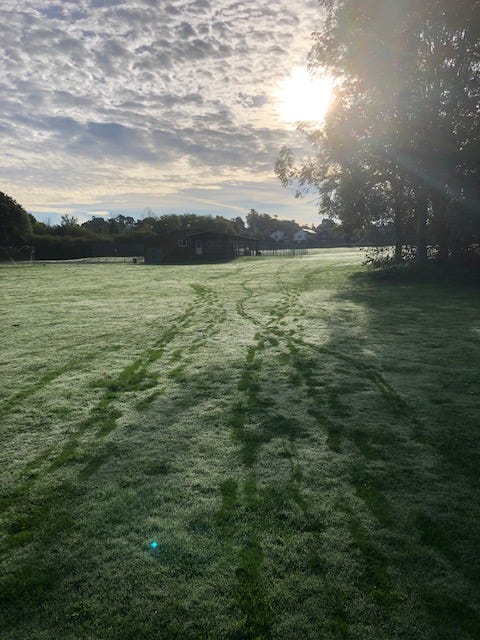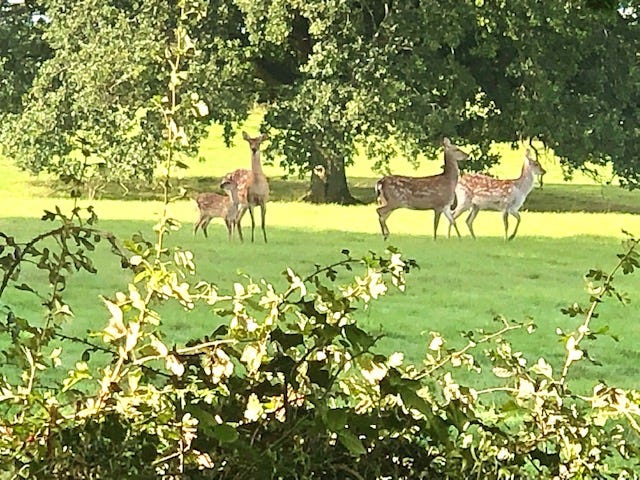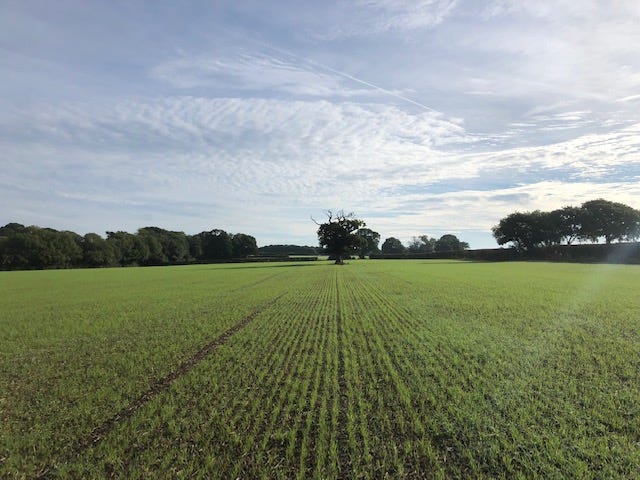Dear Reader,
My walking dreams came true when I unwrapped my size 8 Anatom walking boots on my birthday last year: I was delighted! I immediately swapped the supplied chocolate brown laces for some bright red ones and stomped around the house in them for a few days in order to get used to wearing them.
Once they’d passed the indoors stage I tested them first on short walks and then on longer ones. They were so comfortable in most places that I managed not to be too irritated by the recurrent blister on the inside of my left heel – after all, that’s just what Compeed plasters are for, and I’d been given a packet of those for my birthday, too.
Going from zero kilometres a week to walking at least forty, though, resulted in some unexpected and dramatic changes to my feet. Reader, they grew. The tips of my toes started to bash into the toeboxes of the boots, and although I didn’t suffer the discomfort of the black toenails I used to get during my thankfully brief running career, this wasn’t right at all. Having been out in all weathers in the British autumn and winter my boots spent most of their time being wet and muddy, then being dried (shock, horror) in the airing cupboard.
(Don’t dry your boots in the airing cupboard. Or on a radiator. Or on top of the stove. You’ll thank me later.)
Unsurprisingly they shrivelled and shrank, and eventually the leather parted company altogether with the rubber welt.
Taking advantage of the January sales I splashed out on a new pair, this time in a size 9. Anatoms were out of stock, but I’d heard good things about Brasher boots, so ordered those. They felt huge and unfamiliar to begin with, and whenever I wore them my legs looked more like a pair of golf clubs than the lithe limbs of a keen walker. To start with I wore them with fairly thick hiking socks, but as my feet continued to grow I downsized to slimmer, smoother ones. Eventually I got used to the golf club look, and didn’t really mind: I was very comfortable, and my boots were doing the job.
Until, without my noticing, the loop of my lace caught the top eyelet of the other boot and pulled it clean off, rendering the boot useless. Still under warranty with Brasher, this sadly defective pair took a trip via Royal Mail to be assessed, leaving me bootless and climbing the walls.
No boots, no walks. No release for my pressure valve.
Reader, I went shopping. It’s all very well relying on mail order when you’re as antisocial as I am and prefer the convenience of home delivery, but now that I’m feeling a little less Covid-terrified I felt I could brave my local outdoor clothing and equipment shop.
Boot specialist Simon was brilliant:
“Take your shoes off and let me see the soles. Ah yes, although you have a very even gait across the feet, you land more heavily on your left. VERY high insteps – do you ever get bruises across the top of your feet or numbness in your toes? Both? Gosh. Well, let’s try you with some comfy boots and some alternative lacing styles.”
I left the shop with a pair of leather Hi-Tecs, to my delight by sheer coincidence the most affordable pair I’d tried on, simply because they were the ones. They’d felt comfortable immediately, and once I’d been shown how to lace them in such a way as to not have them pressing too hard against the tops of my feet I was in absolute heaven.
I’ve had a few walks since my new boots were delivered in late August, the longest of which has been 10km. But now I wanted a longer walk, and today was perfect, offering bright sunshine in a dappled blue sky.
As this was a walk I’ve done several times before, in a moment of navigational bravado I decided simply to ‘Record Activity’ on my Ordnance Survey maps app rather than follow a plotted route. To begin with, my surroundings were very familiar: from the centre of the village I walked to the recreation ground and past the children’s playground and tennis courts. I was already glad I’d put my gaiters on: my new boots would otherwise have been quickly soaked by the heavy September dew.

Soon out of the village and into the countryside I noticed that since I’d last been out the post-harvest stubble had been ploughed in and new crops seeded. Most of the footpaths on my route were across fields, and it wasn’t always clear exactly where the paths were. The trajectory arrow on my app was my lifeline at least to start with.
In the high ash trees crows jeered at my apparent disregard for the new seedling crop I was picking my way through. ‘But I’m supposed to go this way’, I explained, more to myself than to them. ‘To go round the edge would be trespassing!’
The next stile was where I’d found a spoon earlier in the summer (you can read about it here). Today though, rather than nestling cosily in the grass beneath it, I saw that the spoon had been placed on the stile in an apparent gesture of defiance.
I present: the incongruous spoon.
I’ll roll that around on my tongue for a while. Incongruous spoooooon. I think on my (limited) list of favourite cutlery descriptors, ‘incongruous’ is second only to Edward Lear’s ‘runcible’, in ‘The Owl and the Pussy-Cat1’.
I left the stile – and its spoon – behind me, casting left-and-right glances into the surrounding grass on the off-chance of finding any more abandoned cutlery.
With the confidence of a girl who thought she knew her way I strode strongly, feeling invincible. Despite a week of bereavement leaving me with a heightened awareness of my own mortality I felt curiously ageless out here in nature.
After the spoon stile I made my way down the centre of a wide field. I always struggle to translate the layout of a map with the shape of its related artefacts in the landscape around me, but the map was telling me that the other end of the field was shaped like a triangle, with my invisible central path leading me straight to its point.
I ran out of path at the end of the field, arriving at a thick blackthorn hedge that was dripping with tiny, plum-like sloes. But this wasn’t the point of a triangle: it wasn’t anything. It was a straight line of hedge with no way of getting through. Yet my map app told me that there should be.
I panicked. What did I need to do? Move to prove, as my long-suffering navigation tutor Allan so enjoys telling me. I did move – sidling left and right along the impenetrable hedge to find a gap, however tiny, to squeeze through – but without any real hope or expectation. Far off to my right, in the hedge I had been walking almost parallel to on my journey through the centre of the field, there was a gap, but I knew that wasn’t it: I needed to carry almost straight on, not right.
Sigh.
Left, then. I turned, and with the blackthorn hedge now on my right I paced along the boundary line until I reached another hedge running left to right in front of me. There, in the corner, inviting me to take a sharp right-hand turn, was my gap.
And looking down at my map app I found it was in the right place after all. It was I who’d been wrong. Reader, I know that you’re not surprised. On my way through the field I’d been veering gradually off to the right, and had ended up around 90° out from where I thought I’d been. The map was on the money: the gap in what had looked like the corner of the field turned out to be exactly the point of the triangle I’d been looking for. I simply hadn’t recognised it for what it was.
I could have cried with relief; something which is becoming a bit of a pattern. Instead I took a long drink from my water pipe, and suddenly feeling more vulnerable than invincible I checked I had a phone signal. Not because I needed to make a call, but to make sure I could if I did.
Calmer, I pressed on, looking forward to finding some shade in the patch of woodland I knew wasn’t far ahead. Two fallow deer, then one more and a fawn, crossed the path in front of me and jumped into the field beside it. They paused, ears up, as we had a good look at each other. Their momentary interest faded and they were suddenly gone, four sets of taut legs flexing in unison to spring them away.
I was enthralled by this encounter. I lingered for a while, leaning against a shady tree trunk. Nature was around me, and everything felt okay. Being out in the wilds couldn’t make something I hadn’t wanted to happen unhappen – the regal pinnacle of our national identity leaving us to become a platinum piece in her own historical jigsaw puzzle – but the time and space for reflection I’d been granted certainly made me feel better about it. I was grateful.
This time for to reflect, to be out in nature and to damp down the sparks of anxiety that make my everyday brain so fizzingly busy, was a precious, precious gift from my new boots. I arrived home tired, four hours after I’d set off, my pink face damp with sweat and my shins sporting splashes of mud like badges of honour, but inside I felt steady, calm and ready for whatever life wants to throw at me.
Thanks, boots.
Love,
Rebecca
If you enjoyed this post, please let me know by clicking the heart. Thank you!
Do you take the opportunity to be out in nature in order to steady yourself in this busy world?
Thank you for reading! If you enjoy ‘Dear Reader, I’m lost’, please share and subscribe for free.
"The Owl and the Pussy-cat" is a nonsense poem by Edward Lear, first published in 1870. The term “runcible”, used for the phrase "runcible spoon", was invented for the poem.
(Taken from Wikipedia.)








Your posts are almost like seeing things in person, well done!
You capture that feeling of panic when the place doesn't quite map out like you imagine perfectly. And I thought it was just me. I'm still not as brave as you to go out in a new wild place yet, but you give me hope. And always, the best shoe sales-people are AMAZING, and provide a life-changing service. Thanks for this post!